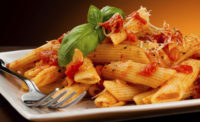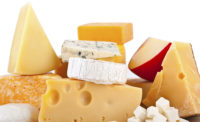Packaged Facts: "Snacks saving restaurant industry"
Snack foods are becoming an integral part of strategies to strengthen consumer spending at restaurants, which increasingly rely on snacks to entice customers to purchase additional foods and beverages, according to "Snack and Dessert Trends in the U.S. Foodservice Market" by research publisher Packaged Facts, New York, N.Y.
"Snackable foods have caught on at a host of restaurant menus, from McDonald's to Dairy Queen to Boston Market to The Cheesecake Factory," says Don Montuori, publisher of Packaged Facts. "Snack foods are the means through which these and other foodservice players are boosting mid-morning and mid-afternoon sales and are driving guest traffic. Plus, snacks possess 'up-selling' potential to higher-priced items and can be incorporated into bundles."
Montuori says Packaged Facts defined a snack as a small portion of food, set in contrast against a (larger) regular meal.
"For example, as part of our proprietary consumer survey commissioned for this report, respondents were given the choice of telling Packaged Facts whether they had visited a restaurant to obtain breakfast, lunch, dinner or a snack," he says. "In addition to their smaller portion size, snack foods are also distinguished by their portability and low price. What constitutes a snack food by content, however, is highly subjective."
Researchers say the "snack-loving cohort" of younger consumers appears to be particularly essential to sustaining -- and perhaps even rescuing -- the restaurant industry. Packaged Facts' research indicates that consumers between 18-24 years old spend the highest percentage of their income on snacks and nonalcoholic beverages, followed by consumers between 25-34 and 35-44. These age brackets also allot the highest share of their restaurant expenses to snack products.
Snacks are popular with consumers of all ages not just because of cost, but also because of portability. According to Packaged Facts' proprietary survey, 60 percent of respondents said they snack on the go while in a car.
Individuals with $100K+ household incomes are most likely to snack on their way to planned activities, being 28 percent more likely than average to do so. Consumers between 18-24 years old -- who typically have more erratic, fast-paced, on-the-go schedules and more planned social and extracurricular activities -- are 27 percent more likely than average to do the same. This emphasizes the importance of providing consumers with handy snacks that are convenient to eat while traveling and conducive to multi-tasking.
Packaged Facts estimates that snack and non-alcoholic beverage sales reached $25.7 billion in 2009, and forecasts that sales will drop slightly to $25.4 billion in 2010, then reach $25.8 billion in 2011.
Packaged Facts says its latest report examines the consumer snacking decision-making process; snacking menu pricing and product trends; and foodservice snacking sales (by restaurant segment and by demographic). Montuori says report also assesses "consumer dessert influencers," factors that play into the decision to order restaurant dessert during the dinner hour. Additionally, the report analyzes the snacking patterns and restaurant preferences of five Snacking Lifestyle groups: Carefree Snackers; Fast Food Slighting Hurried Healthy Snackers; Hurried Healthy Snackers; Calorie-Conscious Small Mealers; and Healthy Calorie-Conscious Snackers.
Packaged Facts is a division of MarketResearch.com.
"Snackable foods have caught on at a host of restaurant menus, from McDonald's to Dairy Queen to Boston Market to The Cheesecake Factory," says Don Montuori, publisher of Packaged Facts. "Snack foods are the means through which these and other foodservice players are boosting mid-morning and mid-afternoon sales and are driving guest traffic. Plus, snacks possess 'up-selling' potential to higher-priced items and can be incorporated into bundles."
Montuori says Packaged Facts defined a snack as a small portion of food, set in contrast against a (larger) regular meal.
"For example, as part of our proprietary consumer survey commissioned for this report, respondents were given the choice of telling Packaged Facts whether they had visited a restaurant to obtain breakfast, lunch, dinner or a snack," he says. "In addition to their smaller portion size, snack foods are also distinguished by their portability and low price. What constitutes a snack food by content, however, is highly subjective."
Researchers say the "snack-loving cohort" of younger consumers appears to be particularly essential to sustaining -- and perhaps even rescuing -- the restaurant industry. Packaged Facts' research indicates that consumers between 18-24 years old spend the highest percentage of their income on snacks and nonalcoholic beverages, followed by consumers between 25-34 and 35-44. These age brackets also allot the highest share of their restaurant expenses to snack products.
Snacks are popular with consumers of all ages not just because of cost, but also because of portability. According to Packaged Facts' proprietary survey, 60 percent of respondents said they snack on the go while in a car.
Individuals with $100K+ household incomes are most likely to snack on their way to planned activities, being 28 percent more likely than average to do so. Consumers between 18-24 years old -- who typically have more erratic, fast-paced, on-the-go schedules and more planned social and extracurricular activities -- are 27 percent more likely than average to do the same. This emphasizes the importance of providing consumers with handy snacks that are convenient to eat while traveling and conducive to multi-tasking.
Packaged Facts estimates that snack and non-alcoholic beverage sales reached $25.7 billion in 2009, and forecasts that sales will drop slightly to $25.4 billion in 2010, then reach $25.8 billion in 2011.
Packaged Facts says its latest report examines the consumer snacking decision-making process; snacking menu pricing and product trends; and foodservice snacking sales (by restaurant segment and by demographic). Montuori says report also assesses "consumer dessert influencers," factors that play into the decision to order restaurant dessert during the dinner hour. Additionally, the report analyzes the snacking patterns and restaurant preferences of five Snacking Lifestyle groups: Carefree Snackers; Fast Food Slighting Hurried Healthy Snackers; Hurried Healthy Snackers; Calorie-Conscious Small Mealers; and Healthy Calorie-Conscious Snackers.
Packaged Facts is a division of MarketResearch.com.
Looking for a reprint of this article?
From high-res PDFs to custom plaques, order your copy today!




